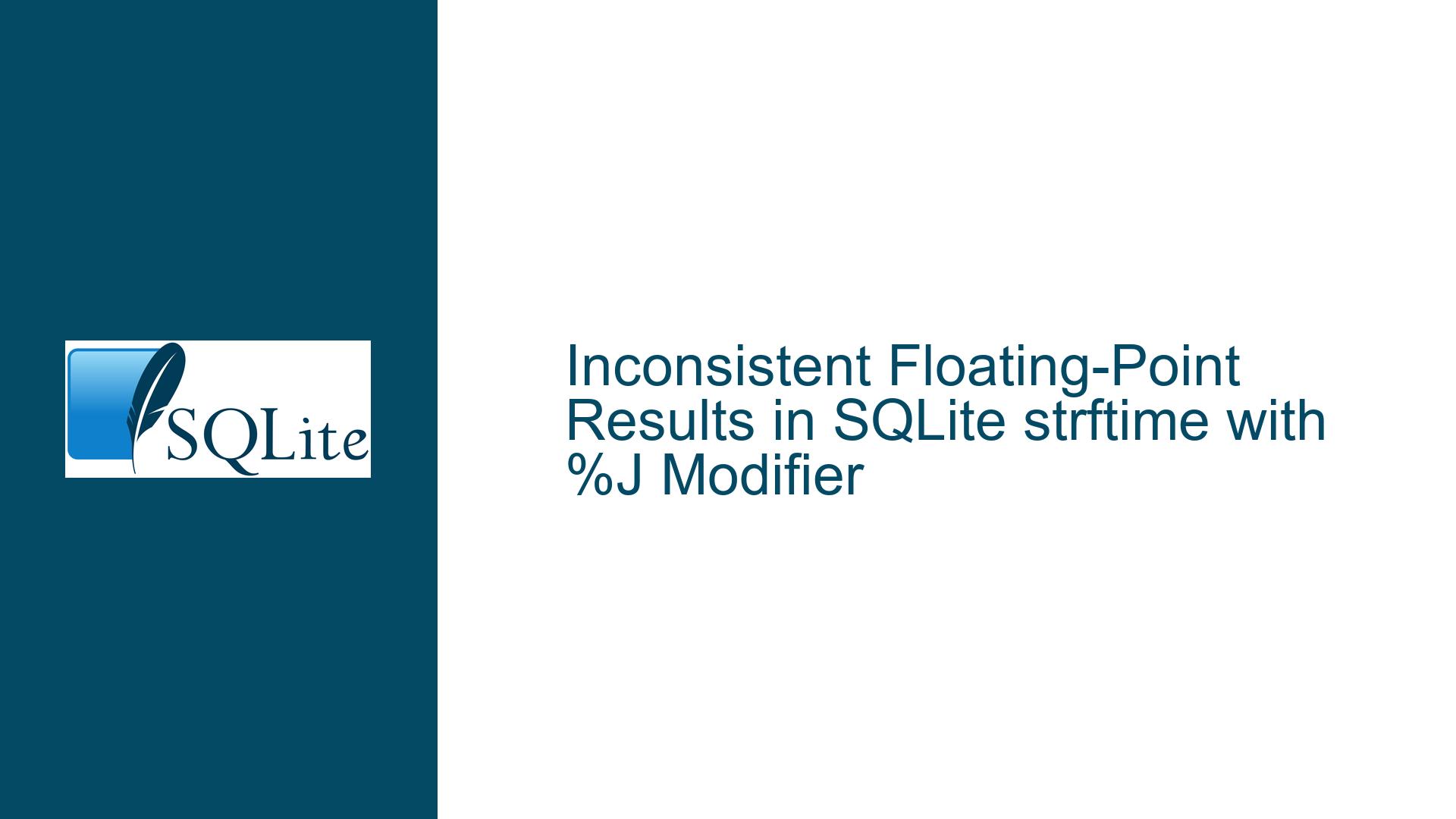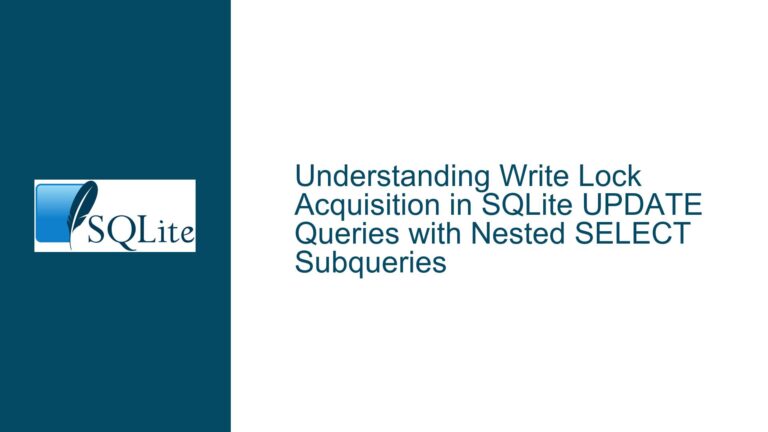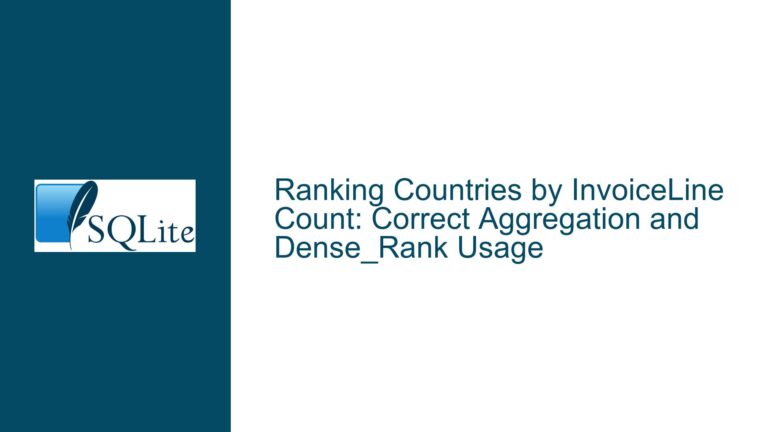Inconsistent Floating-Point Results in SQLite strftime with %J Modifier
Floating-Point Precision and strftime Behavior in SQLite
Issue Overview
The core issue revolves around the inconsistent results returned by the SQLite strftime function when using the %J modifier to convert a datetime string into a Julian Day Number (JDN). Specifically, the same datetime input ('2022-02-11 17:00:00') produces slightly different floating-point results when queried multiple times. For example, the output alternates between 2459622.208333334 and 2459622.208333333. This discrepancy, while minor, raises questions about the reliability of floating-point arithmetic in SQLite, particularly when dealing with datetime conversions.
The %J modifier in SQLite’s strftime function is designed to return the Julian Day Number as a floating-point value, which includes the fractional part representing the time of day. Julian Day Numbers are a continuous count of days since a fixed point in time (noon on January 1, 4713 BCE, in the proleptic Julian calendar). The fractional part of the JDN corresponds to the time of day, with 0.5 representing noon. Given that floating-point arithmetic is inherently approximate, small variations in the least significant digits are expected. However, the observed inconsistency in the results for the same input is unusual and warrants a deeper investigation.
The issue is further complicated by the involvement of external factors such as the programming language (Go), the operating system (Windows Server 2022), and the hardware architecture (amd64). These factors can influence floating-point computations, especially when different floating-point units or compiler optimizations come into play. Additionally, the discussion hints at a potential misunderstanding of the strftime function’s behavior, particularly regarding the use of field widths in the format string (e.g., %25J), which is not supported by SQLite.
Possible Causes
The inconsistency in the results returned by strftime('%J', '2022-02-11 17:00:00') can be attributed to several factors, each of which plays a role in the behavior of floating-point arithmetic and datetime conversions in SQLite.
Floating-Point Precision Limitations: Floating-point numbers are inherently approximate due to the way they are represented in binary. SQLite uses IEEE 754 double-precision floating-point numbers, which have a precision of about 15-17 decimal digits. Small rounding errors can occur during arithmetic operations, leading to variations in the least significant digits. In this case, the difference between
2459622.208333334and2459622.208333333is in the 15th significant digit, which is within the expected range of floating-point precision limitations.Hardware and Compiler Influences: The hardware architecture and the compiler used to build SQLite can affect floating-point computations. Different floating-point units (FPUs) or compiler optimizations may handle intermediate calculations differently, leading to slight variations in the final result. For example, some FPUs may retain carry bits from previous computations, which can influence the least significant digits of the result. This behavior is often considered acceptable in floating-point arithmetic, as it does not impact the overall accuracy of the computation.
Operating System and Runtime Environment: The operating system and runtime environment (e.g., Go) can also influence floating-point behavior. For instance, the Go runtime may use different floating-point libraries or optimizations compared to other environments, leading to subtle differences in the results. Additionally, the operating system’s handling of floating-point exceptions or rounding modes can affect the outcome of floating-point operations.
Misuse of strftime Format Specifiers: The initial query in the discussion used an incorrect format specifier (
%25J), which is not supported by SQLite. While this was later corrected to%J, the confusion highlights a potential misunderstanding of thestrftimefunction’s capabilities. SQLite’sstrftimefunction does not support field widths in the format string, and attempting to use them can lead to unexpected behavior or errors.Datetime Parsing and Conversion: The process of converting a datetime string (
'2022-02-11 17:00:00') into a Julian Day Number involves several steps, including parsing the input string, calculating the Julian Day Number, and converting the result to a floating-point value. Each of these steps introduces opportunities for small rounding errors or inconsistencies, particularly when dealing with fractional parts of the day.
Troubleshooting Steps, Solutions & Fixes
To address the inconsistency in the results returned by strftime('%J', '2022-02-11 17:00:00'), the following troubleshooting steps and solutions can be applied:
Understand Floating-Point Precision: The first step is to recognize that floating-point numbers are inherently approximate and that small variations in the least significant digits are expected. The difference between
2459622.208333334and2459622.208333333is negligible and does not impact the overall accuracy of the computation. If precise decimal representation is required, consider using fixed-point arithmetic or a decimal data type instead of floating-point.Verify Hardware and Compiler Settings: Ensure that the hardware and compiler settings are consistent across different runs of the query. If possible, test the query on different hardware architectures or with different compilers to determine if the inconsistency is specific to a particular environment. Additionally, check for any compiler optimizations or floating-point settings that may affect the results.
Check Operating System and Runtime Environment: Investigate the operating system and runtime environment for any factors that may influence floating-point behavior. For example, check the Go runtime’s floating-point settings or the operating system’s handling of floating-point exceptions. If necessary, adjust the runtime environment to ensure consistent floating-point behavior.
Use Correct strftime Format Specifiers: Ensure that the correct format specifiers are used in the
strftimefunction. SQLite’sstrftimefunction does not support field widths in the format string, so avoid using unsupported specifiers like%25J. Instead, use the correct specifier (%J) to obtain the Julian Day Number as a floating-point value.Round the Result to a Fixed Precision: If the inconsistency in the least significant digits is problematic, consider rounding the result to a fixed precision. For example, use the
roundfunction to round the result to 9 decimal places, which corresponds to the precision of the fractional part of the day (1 second = 1/86400 ≈ 0.00001157407407407407 days). This will ensure consistent results across different runs of the query.Test with Different Datetime Inputs: Test the
strftimefunction with different datetime inputs to determine if the inconsistency is specific to a particular input or occurs across all inputs. If the inconsistency is limited to specific inputs, investigate the parsing and conversion process for those inputs to identify any potential issues.Consult SQLite Documentation and Community: Refer to the SQLite documentation and community resources for additional insights into the behavior of the
strftimefunction and floating-point arithmetic. The SQLite documentation provides detailed information on the supported format specifiers and the limitations of floating-point arithmetic. Additionally, the SQLite community can provide valuable feedback and suggestions for addressing the issue.Consider Alternative Approaches: If the inconsistency in the results is unacceptable, consider alternative approaches to datetime handling in SQLite. For example, store datetime values as integers (e.g., Unix timestamps) or use a custom function to perform datetime conversions with fixed-point arithmetic. This will eliminate the variability introduced by floating-point arithmetic and ensure consistent results.
By following these troubleshooting steps and solutions, the inconsistency in the results returned by strftime('%J', '2022-02-11 17:00:00') can be effectively addressed. Understanding the limitations of floating-point arithmetic, verifying the hardware and software environment, and using correct format specifiers are key to ensuring reliable and consistent datetime conversions in SQLite.






